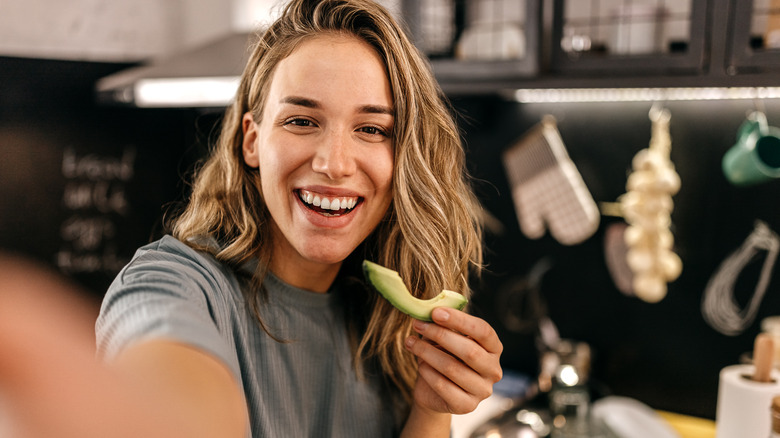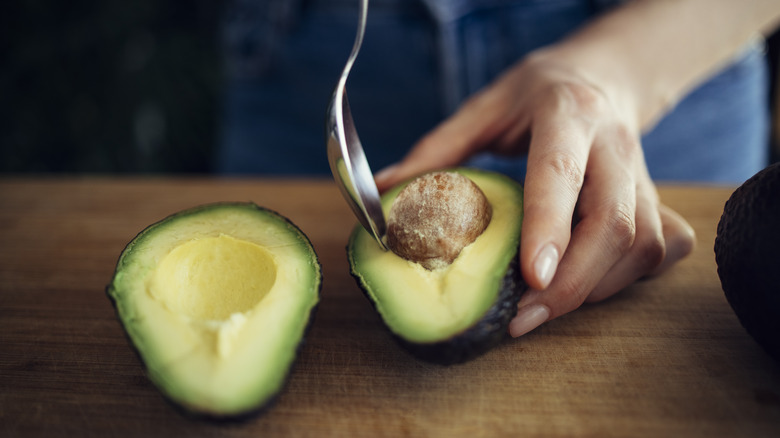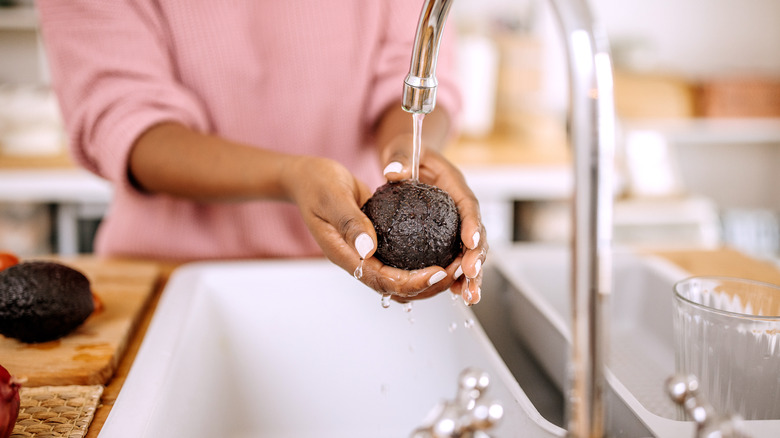Avocados Have An Unexpected Amount Of Protein
They are notorious for ripening when you look away from them for two seconds, but avocados are a popular breakfast ingredient for most — cue avocado smoothies, avocado on toast, and avocado slices in your oatmeal.
And it's not just the creamy and rich consistency of the fruit's flesh that people are after. The fruit is packed full of many essential nutrients like fiber, healthy fats, vitamins C, E, K, B2, and B6, folate, magnesium, and potassium (via Medical News Today). They're also low in sugar for a fruit. Breakfast is not the only time you can enjoy them. Got an unexpected group of friends visiting in the evening? Whip up a quick guacamole dip to pair with sweet potato fries, add them to a refreshing salad, or even create some delicate sushi rolls with avocados as the star. There's no end to what meals you can use them in and what other dishes they can be paired with.
Did you know that avocados also have an unexpected amount of protein in them? A cup of sliced avocados contains as much as 3 grams of protein, per WebMD. That might not seem like much compared to regular protein sources like lean meats, eggs, and plant-based options like lentils and chickpeas, but it is still noteworthy in the fruit kingdom. Does this mean an avocado every day is what the doctor ordered?
Should you be adding avocados to your everyday diet?
As long as you're mindful of portion sizes, there's nothing wrong with incorporating avocados into your regular diet, as experts suggest. Head of nutrition for Nucific, Dr. Amy Lee told Reader's Digest that the important thing to do is be mindful of how the fruit fits into your overall daily diet.
"The amount you should eat really depends on what else you are eating. Avocado is higher in fat — good fat (monounsaturated), to be exact — compared with all fruits, which can translate to more calories, so it's important to be aware of how much you're eating for caloric purposes," explained the nutritionist.
When you eat too much avocado, you might irritate your stomach, especially if you have underlying health conditions like irritable bowel syndrome (IBS), added Toronto-based registered dietitian, Shauna Lindzon (via Global News). The carbohydrates polyols and sorbitol in avocados can lead to stomach cramps, bloating, and diarrhea, per the dietician. Even the high fiber content in the fruit (13.5 grams per avocado) can become problematic for your gut when consumed in excess. Also, if you've ever sat down with a bowl of chips and guacamole dip, you probably know how filling avocados can be. When you're fully satiated with one type of food, you may not seek other nutrients to balance your daily diet, according to registered dietician Shena Jaramillo (via Eat This, Not That).
How should you be eating your avocados then?
As mentioned earlier, incorporating them into your diet first thing in the morning is a popular choice. There are plenty of sweet and savory recipes you can choose from — the classic mashed avocado on toast, sweet avocado bread (if you're feeling particularly adventurous), or simply adding them to a smoothie with frozen bananas, pineapples, spinach, coconut milk, and lime juice.
If you're thinking of consuming the fruit for lunch, a quinoa protein bowl would make an excellent choice. You can combine the fruit's unexpected nutrient content with other protein-rich sources like quinoa, chicken breast, and toasted almonds and pair salt, pepper, olive oil, apple cider vinegar, dijon mustard, and some sweet potatoes — you're good to go. The great thing about protein bowls is that you can customize them to your preference.
Avocado BLT club sandwiches are an easy option for dinners. Choosing the perfect avocado goes a long way too, registered dietitian Julia Zumpano told Cleveland Clinic. They range in size, shape, hues, and texture. What you want is a fruit that's firm but not too hard, shared Zumpano. "If it's not ripe but you can't wait to eat it, store it in a paper bag on the counter until it gives a little when you squeeze it," explained the dietician, adding that it's also possible to save the fruit for later once you've cut into it. All you have to do is freeze the slices in a Ziplock bag.


